| - |
Matter, Energy,
and Direct Current |
| - |
Alternating Current and Transformers |
| - |
Circuit Protection, Control, and Measurement |
| - |
Electrical Conductors, Wiring Techniques,
and Schematic Reading |
| - |
Generators and Motors |
| - |
Electronic Emission, Tubes, and Power Supplies |
| - |
Solid-State Devices and Power Supplies |
| - |
Amplifiers |
| - |
Wave-Generation and Wave-Shaping Circuits |
| - |
Wave Propagation, Transmission Lines, and
Antennas |
| - |
Microwave Principles |
| - |
Modulation Principles |
| - |
Introduction to Number Systems and Logic Circuits |
| - |
- Introduction to Microelectronics |
| - |
Principles of Synchros, Servos, and Gyros |
| - |
Introduction to Test Equipment |
| - |
Radio-Frequency Communications Principles |
| - |
Radar Principles |
| - |
The Technician's Handbook, Master Glossary |
| - |
Test Methods and Practices |
| - |
Introduction to Digital Computers |
| - |
Magnetic Recording |
| - |
Introduction to Fiber Optics |
| Note: Navy Electricity and Electronics Training
Series (NEETS) content is U.S. Navy property in the public domain. |
NEETS Module 17 - Radio-Frequency Communications Principles
Pages i,
1-1,
1-11,
2-1,
2-11,
2-21,
2-31,
3-1,
3-11,
3-21,
3-31,
3-41,
4-1- to 4-10,
4-11,
5-1,
5-11, Index
Most speakers of the above type receive their input by means of transformer coupling.
This is necessary because of the normal, low impedance of the voice coil. You will
find the standard impedance values for this type speaker are 4, 8, 16, and 32 ohms.
Other impedance values may be obtained, but those listed are the most common.
While permanent magnet speakers perform reasonably well in the audio range, they
have limitations. Most Navy speakers reproduce low audio frequencies quite well,
mid-band frequencies fairly well, and high frequencies quite poorly. Let's see why.
When the speaker is constructed, only a limited number of turns may be built into
the voice coil. This gives us a fixed inductance. At low frequencies, the inductive
reactance of the voice coil is relatively low, and large audio currents flow. This
provides a strong magnetic field around the voice coil and a strong interaction
with the field of the permanent magnet. Low frequency response is excellent. At
midband frequencies, inductive reactance increases and less current flows in the
voice coil. This produces less magnetic field and less interaction. Midband response
is still acceptable in a properly designed speaker. At high audio frequencies inductive
reactance is quite high, and little current flows in the voice coil. This results
in a greatly reduced voice coil field and little interaction with the permanent
magnetic field. Also at high frequencies the interwinding capacitance of the voice
coil tends to shunt some of the high audio frequencies, which further reduces the
high frequency response.
Frequency response of most permanent magnet speakers falls off at the higher
audio frequencies. This problem is normally overcome either by the use of an expensive,
specially designed speaker, or through the use of two speakers, one of which is
designed to operate well at the higher audio frequencies (tweeter) and one at the
lower frequencies (woofer).
As shown in figure 2-31, an electromagnet may be used in place of a permanent
magnet to form an electromagnetic dynamic speaker. When we do this, sufficient dc
power must be available to energize the field electromagnet. The operation otherwise
is much the same as that of the permanent magnet type. This type of speaker is seldom used in Navy equipment.
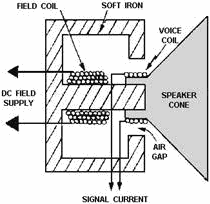
Figure 2-31. - Electromagnetic speaker.
2-31
Figure 2-32 shows a diagram of typical headphones used with Navy equipment. The
device consists of a permanent magnet and two small electromagnets through which
the signal currents pass. a soft iron diaphragm is used to convert the electrical
effects of the device into sound power. When no signal currents are present, the
permanent magnet exerts a steady pull on the soft iron diaphragm. Signal current
flowing through the coils mounted on the soft iron pole pieces develops a magnetomotive
force that either adds to or subtracts from the field of the permanent magnet. The
diaphragm thus moves in or out according to the resultant field. Sound waves are
then reproduced that have an amplitude and frequency (within the mechanical capability
of the reproducer) similar to the amplitude and frequency of the signal currents.
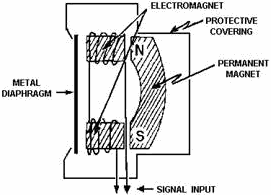
Figure 2-32. - Headphone.
As compared to permanent magnet speakers, standard headphones are considered
to be high- impedance devices. Headphone electromagnets are normally wound with
many turns of small wire, which provide the larger impedance. Because of the physically
small size and inflexibility of the metal diaphragm, the headphones often give poor
response to the lower audio frequencies. In the voice range of audio, most standard
issue headphones are adequate.
Summary
In this chapter you learned transmitter and receiver fundamentals. We also discussed
modes of operation and special controls circuits. Let's review some of these areas.
A Harmonic is an exact multiple of the fundamental frequency.
Even harmonics are 2, 4, and so on, times the fundamental. Odd are 3, 5, and so
on, times the fundamental frequency.
A SUBHarmonic is an exact submultiple of the fundamental frequency.
Even subharmonics are one-half, one-quarter, and so on. Odd subharmonics are one-third,
one-fifth, and so on, of the fundamental frequency.
SUPPRESSION is the process of eliminating an undesired portion
of a signal.
2-32
MULTIPLEXING is a method for simultaneous transmission of two
or more signals over a common carrier wave.
An ORDER-Wire Circuit is a circuit between operators used for
operations control and coordination.
RECEPTION is when an electromagnetic wave passes through a receiver
antenna and induces a voltage in that antenna.
DETECTION is the separation of low-frequency (audio) intelligence
from the high (radio)
frequency carrier.
REProductION is the process of converting electrical signals
to sound waves. This sound is speech, music, and so on.
SENSITIVITY of a receiver is the ability to reproduce weak signals.
The greater the receiver sensitivity, the weaker the signal that will be reproduced.
Receiver SELECTIVITY is the ability to select the desired signal
and reject unwanted signals.
NOIsE SILENCER, NOIsE SUPPRESSOR, or NOIsE LIMITER,
are circuits that clip the peaks of the noise spikes in a receiver.
SQUELCH is a circuit that cuts off the output of a receiver
when there is no input.
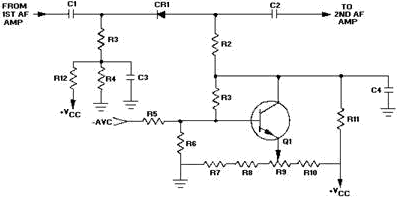
A BALANCED-Phase DETECTOR or Phase-DIsCRIMINATOR
is a circuit that controls the oscillator frequency (AFC).
2-33

Frequency SYNTHESIs is a signal-producing process through heterodyning
and frequency selection.
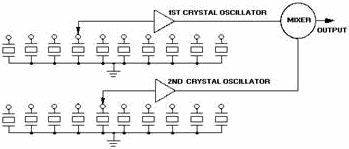
A PERMANENT MAGNET SPEAKER is one with a permanent magnet mounted
on soft iron pole pieces.
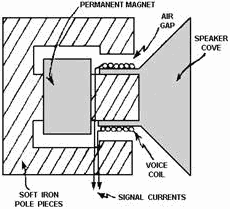
2-34
The Fidelity of a receiver is the ability to accurately reproduce
at its output the signal at its input.
GANGED TUNING is the process used to tune two or more circuits
with a single control.
HETERODYNING is the mixing of the incoming signal with the local
oscillator frequency. This produces the two fundamentals and the sum and difference
frequencies.
An IMAGE Frequency is an undesired frequency capable of producing
the desired frequency through heterodyning.
AUTOMATIC VOLUME/Gain CONTROL is a circuit used to limit variations
in the output signal strength of a receiver.
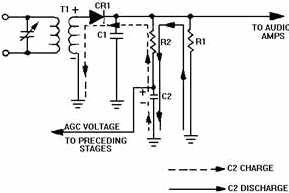
FADING is the variations in signal strength at the antenna of
a receiver.
REVERSE AGC is when an amplifier is driven toward cutoff.
2-35
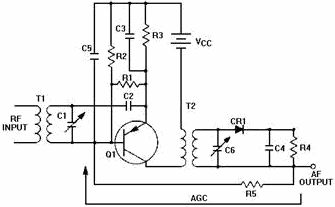
forWARD AGC is when an amplifier is driven toward saturation.
A BEAT-Frequency Oscillator is an additional oscillator used
in a receiver when the receiver is receiving a CW signal and provides an audible
tone.
2-36
Answers to Questions Q1. Through Q26.
A1. AM, FM, CW, SSB.
A2. It generates an RF carrier at a given frequency within required
limits.
A3. Power amplifier.
A4. It converts audio (sound) into electrical energy.
A5. When no modulation is present.
A6. It is an exact multiple of the basic or fundamental frequency.
A7. 600 megahertz.
A8. To obtain higher carrier frequencies.
A9. It saves power and frequency bandwidth.
A10. For operator-to-operator service messages and frequency changes.
A11. Reception, selection, detection, and reproduction.
A12. Sensitivity, noise, selectivity, and fidelity.
A13. Heterodyning.
A14. To extract the modulating audio signal.
A15. Wide bandpass.
A16. a special type of detector and a carrier reinsertion oscillator.
A17. Attenuates the strong and amplifies the weak.
A18. To limit unwanted variations in the output.
A19. Weak signals produce bias, which could result in no usable receiver
output.
A20. DAGC does not attenuate weak signals.
A21. It is heterodyned with the RF to produce an audio frequency.
A22. It eliminates noise when no signal is being received.
A23. It controls the amount of bass and treble response.
A24. It is used to achieve maximum selectivity.
A25. It is used to accurately control the frequency of the oscillator.
A26. The process of selecting and/or heterodyning frequencies to
produce a signal frequency.
2-37
|















